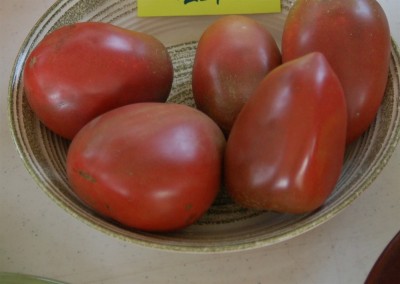Growing Tomatoes
- Start seeds in sterile seed starting mix, 6-8 weeks before plant out date. See Seed Starting
- Germination temperature 75-85 degrees 6-14 days for germination.
- Transplant to 3-4” pot after first set of true leaves appear. Keep under Lights to prevent stretching. If needed transplant again before setting out. Always plant deeper, for final planting 1/2 to 3/4 of plant for sturdier plants.
- Fertilize with fish fertilizer 1/2 strength when have first set of leaves. When 3-4 weeks old full strength till harvest. Do this weekly.
- Harden off for 7 days to till adjusted to weather. During hot weather they may need shade at first when planted out even after hardening off.
- Space 24-36” in beds. Support & stake as they grow. Plant deep, if very leggy leave only a couple inches out the stems will grow roots.
- Can also be grown in containers at least 12-14″ deep or larger for larger size tomatoes.
- Full sun. 60-90 days to harvest depending on variety. Will keep producing till freeze. If temperatures stay above 90 degrees for too long they will stop pollinating until the temps lower again then they will start to produce again.
- To save seeds let fully ripen then use fermentation process.
It is very important to develop a strong seeding when starting tomatoes. Keeping them under florescent
lights until about 5″ tall (adjusting as they grow) helps to create a sturdier transplant. Be careful of sunny
window sills or putting them outside during the day when they are small. The heat, sun or cold could kill or stunt them.
I always start mine in cells and pot up to 3-4″ pot like I do with pepper seedlings. It is better to have to
pot up again if necessary before planting out than to start later because they take so long to produce fruit.
There are two types of growing styles: Determinate (Shorter and bushy plant) & Indeterminate (Long vines, taller plants) Either way they need
support.
Growing Tomatoes And How to Save Tomato Seeds
When/How to Start Indoors:
Tomato plants are regularly started indoors from 4-6 weeks before the last spring frost and transplanted outdoors when soils have warmed. Plant tomato seeds ¼ inch deep into small containers of potting soil, making sure to keep soil moist. Transplant tray-grown seedlings into 3-inch pots when two to three leaves have formed, keeping plants in a light, well-ventilated location.
Time to Germination:
Seeds will germinate in 7-14 days when started indoors.
When to Transplant:
Transplant tomato seedlings outdoors in a sunny spot as soon as the soil has warmed and after all danger of frost has passed. Gradually harden off –introduce the seedlings to the direct sunlight, dry air, and cold nights—and plant outside when there is no danger of frost and air temperatures are at least 45 degrees F, with soil temperatures at a minimum of 50 degrees F.
Spacing Requirements:
Most varieties require ample space to grow, so space your plants 24–48 inches apart in rows at least 36 inches apart.
Special Considerations:
Both indeterminate and determinate tomato varieties typically require trellising, staking, or caging to keep the tomato vines off the ground, where they are more susceptible to disease. Be sure to keep them moist but not waterlogged; erratic watering causes the fruit to split and encourages blossom end rot.
Common Pests and Diseases (and how to manage):
Tomato plants are susceptible to early blight, blossom end rot, late blight, tomato mosaic virus, and many other diseases. Rotating crops, removing diseased plants, and staking or caging plants can help prevent these diseases or curb their spreading, as can mulching the base of the plants.
Harvest (when and how): Harvest tomatoes when they are firm to the touch but seem to give a little. Ripe fruits will pull easily from the vine. Ripening takes about 7-8 weeks from planting for determinate (or “bush”) types and about 10-12 weeks for indeterminate varieties.
Life Cycle:
The tomato is an annual crop. It will complete its full life cycle—including germination, reproduction, and death—in one growing season.
Recommended Isolation Distance:
When saving seeds from tomato, separate varieties by 10-50 feet.
Recommended Population Sizes:
A single tomato plant can produce viable seed. To maintain a variety over time, save seeds from between 5-10 plants.
How to Save Seeds from Tomato Seeds
Tomatoes make an ideal crop for the beginning seed saver as they are self-pollinating and produce seed the same season as planted. Better yet, you only need a few fruit to get started.
Assessing Seed Maturity:
Tomato seeds are mature when the fruit is ready to eat.
To save seeds from tomatoes, squeeze out the pulp and seeds from the inside of the fruit into a container.
Cleaning and Processing:
Leave the container to sit for at least one day in a warm (80-90 degrees F) spot out of direct sunlight so that the pulp can ferment. This process allows the tomato seeds to separate from the gelatinous coating that covers them. Viable seed will sink to the bottom of this mixture, and dead seeds will float. When a small amount of mold begins to form on the mixture, pour off the floating solids and dead seeds and thoroughly rinse the sunken seeds in running water. (A fine mesh strainer is ideal for this step of the process.) Once thoroughly cleaned, seeds can be placed on a screen or a coffee filter and left to dry for 5-7 days.
Storage and Viability:
When stored in a cool, dry place, tomato seeds will remain viable for 5-10 years.







